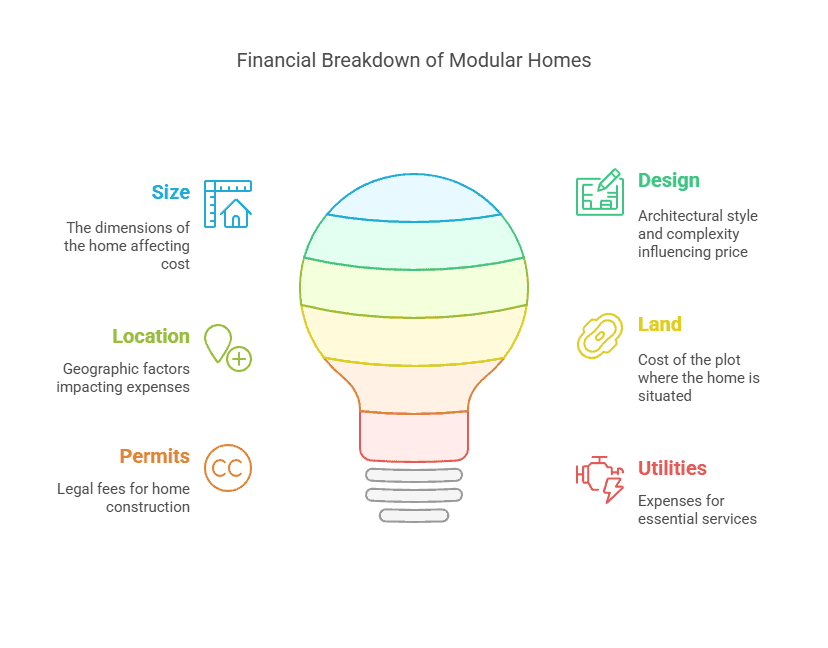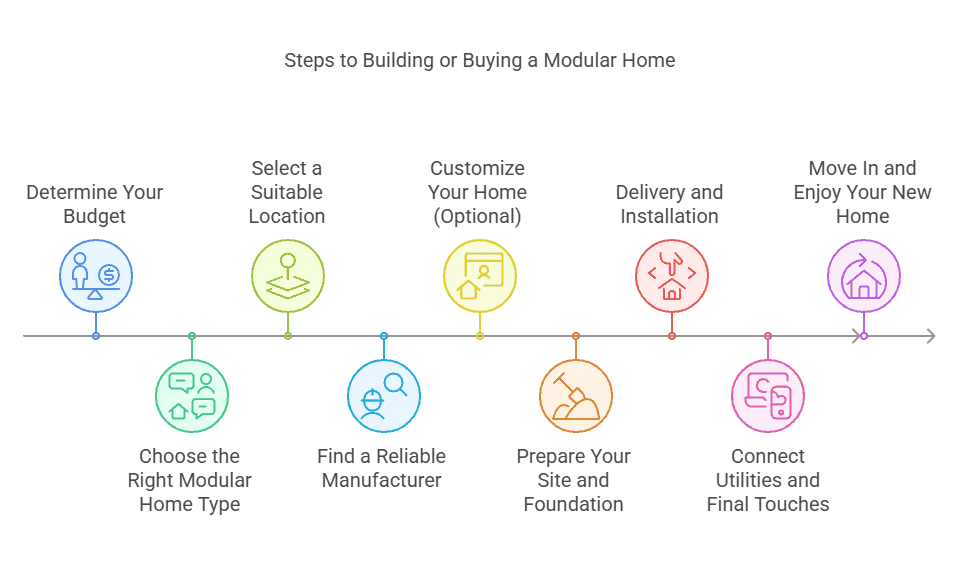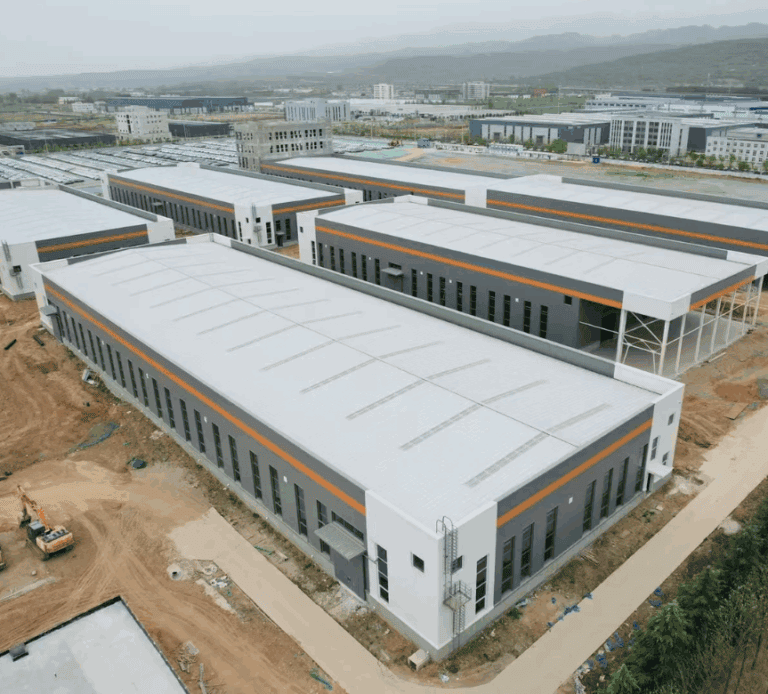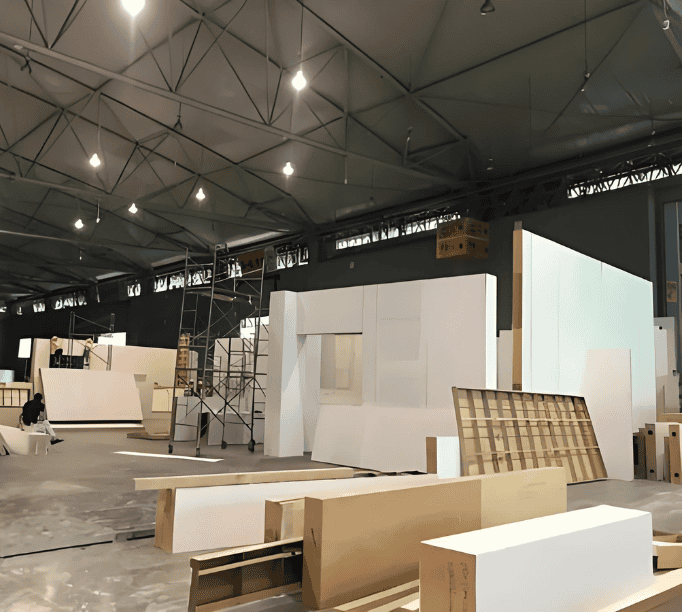El precio de una casa modular suele oscilar entre $50.000 a $300.000, dependiendo del tamaño, tipo de estructura y nivel de personalización.
En esta guía completa de precios, SteelPRO PEB, fabricante certificado de casas modulares y proveedor directo de fábrica, Desglosa todos los factores que afectan el costo, desde los materiales básicos hasta el terreno y la instalación.
Aprenderá cuánto cuestan realmente las casas modulares, qué gastos ocultos y adicionales esperar y cómo varían los precios según el tipo de casa, incluidas las pequeñas, las de doble ancho, las expandibles, las de lujo y las de dos pisos. casas modulares con estructura de aceroTambién cubriremos lo real. costo de colocar una casa modular en un terreno, ofrecen formas prácticas de Ahorrar dineroy explicar por qué las casas modulares siguen siendo una inversión inteligente a largo plazo en comparación con las construcciones tradicionales.
Con más de una década de experiencia en fabricación global, SteelPRO PEB proporciona información transparente basada en la fábrica para ayudarlo a tomar una decisión informada y rentable sobre su casa modular.
¿Cuánto cuesta realmente una casa modular?
Una casa modular básica suele costar entre $50,000 y $150,000, dependiendo de su tamaño, ubicación y personalización. Este precio suele cubrir casas más pequeñas o modelos básicos, mientras que las casas más grandes o con más personalización cuestan más.
Desglose de precios de casas modulares
A continuación se muestra un desglose aproximado de lo que está incluido en el precio de una casa modular:
- Base Home:Esto incluye la estructura en sí: paredes, pisos, techo, etc. El costo típico varía entre aproximadamente $50 a $100 por pie cuadrado.
- TierraSi aún no posee un terreno, comprarlo tendrá un costo adicional. El terreno puede variar desde $5,000 a $100,000 o más dependiendo de la ubicación.
- Preparación del sitio y cimentación:Preparar el terreno (nivelar, limpiar) y colocar los cimientos puede costar entre $5,000 y $20,000.
- Entrega e instalación:Los gastos de transporte e instalación de la casa modular en el lugar de construcción varían generalmente entre $10,000 a $20,000 dependiendo de la distancia involucrada y el nivel de complejidad.
- Personalización y actualizaciones:Si elige acabados, planos de planta o características personalizados, espere pagar entre $10,000 a $50,000 Dependiendo de lo que selecciones.
Factores que afectan el precio de las casas modulares
Varios factores pueden influir en el coste final de su casa modular:
- Tamaño y disposiciónLas casas más grandes o con diseños más elaborados aumentarán el costo total. Cuantos más dormitorios y baños necesite, mayor será el precio.
- Materiales y calidadLa elección de los materiales (por ejemplo, madera o estructura de acero) y la calidad de la construcción influirán en el precio. Los acabados de alta calidad, como encimeras de granito o pisos de madera noble, también aumentarán el costo.
- UbicaciónEl precio del terreno puede variar considerablemente según la ubicación donde se construya. Los costos de construcción, incluyendo la entrega y la instalación, también pueden aumentar si se encuentra en una zona remota o con alta demanda.
- PersonalizaciónCuanto más características personalizadas desee (como planos de planta únicos, opciones de eficiencia energética o acabados de lujo), más cara será la casa.
Lectura relacionada: Costo de una casa prefabricada
Costos ocultos y adicionales a considerar
Si bien el precio base de una casa modular es claro, hay otros costos que debes planificar y que pueden no ser inmediatamente obvios.
Costos de desarrollo del terreno
Si compra un terreno nuevo, podría necesitar invertir en desarrollos adicionales como carreteras, entradas para vehículos o paisajismo. Estos costos pueden fluctuar significativamente según el estado y la ubicación del terreno. La preparación del terreno para la construcción también podría requerir análisis de suelo o evaluaciones de impacto ambiental, lo que añade un costo adicional. $1,000 a $5,000.
Tarifas de permisos e inspección
Se requieren permisos de construcción e inspecciones locales para cualquier proyecto de construcción, incluidas las casas modulares. Dependiendo de dónde se construya, estas tarifas pueden variar desde $500 a $5,000Es esencial consultar con las autoridades locales para comprender los requisitos específicos para la construcción de casas modulares en su área.
Seguro
Su casa modular requiere un seguro, tanto durante la fase de construcción como una vez finalizada. El seguro de construcción puede costar... $1,000 a $3,000 Dependiendo del alcance del proyecto, mientras que el seguro del propietario para la casa terminada generalmente varía entre $500 a $2,000 anualmente.
Actualizaciones de servicios públicos
En algunas zonas, podría ser necesario actualizar los servicios públicos existentes (agua, electricidad, alcantarillado) para adaptar su casa modular. Si su terreno carece de estas conexiones, o si necesitan actualizarse para cumplir con los códigos locales, los costos pueden variar desde $2,000 a $10,000.
Problemas de acceso al sitio y terreno
Si su sitio es de difícil acceso, podrían surgir costos adicionales por equipos especiales (como grúas para entrega o modificación del terreno). En sitios con poca accesibilidad, estos costos pueden ser tan altos como $5,000 o más.
Costos de financiamiento adicionales
Si financia su casa modular, podría incurrir en costos adicionales, como comisiones de apertura del préstamo, comisiones de tasación y otros cargos. Asegúrese de preguntar sobre los costos ocultos al analizar las opciones de financiamiento, ya que pueden ascender a... $1,000 a $3,000.

¿Cuánto cuesta poner una casa modular en un terreno?
Instalar una casa modular en un terreno implica varios gastos adicionales más allá de la propia estructura, entre ellos: Construcción de cimientos, preparación del sitio, entrega y conexiones de servicios públicosEn promedio, estos costos combinados pueden variar entre $15,000 y $30,000, dependiendo de la ubicación, el terreno y el tamaño de la casa.
Gastos típicos relacionados con el terreno:
- Preparación de cimientos y terreno: $5,000–$15,000
- Conexiones de servicios públicos (agua, electricidad, alcantarillado): $2,000–$10,000
- Transporte e instalación de grúas: $3,000–$5,000
A diferencia de las ventas de casas modulares realizadas por concesionarios, Acero PRO PEB proporciona servicio llave en mano de fábrica a sitio, incluido fabricación, entrega e instalaciónNuestro equipo de ingeniería se asegura de que cada casa modular sea diseñado, fabricado y ensamblado de acuerdo a Normas ISO y CE, con todos los ajustes relacionados con la tierra manejados profesionalmente para ahorrar tiempo y reducir costos.
Consejo de fábrica: Elegir un fabricante que ofrezca servicios completos de instalación y cimentación puede reducir el tiempo total del proyecto hasta en 30% y evitar costos ocultos de múltiples contratistas.
Desglose de costos por tipo de casa modular
Casas modulares pequeñas
Pequeñas casas modulares Son la opción más asequible, lo que las convierte en una excelente opción para personas o parejas que buscan reducir su tamaño o una casa de vacaciones. El costo suele oscilar entre $50.000 a $75.000 Para un modelo básico. Estas casas suelen ser compactas, con menos habitaciones y diseños más sencillos, lo que reduce el costo.
- Ideal para:Propietarios de vivienda por primera vez, particulares o aquellos que buscan una segunda residencia o propiedad de vacaciones.
- Ventajas:Menor costo, construcción rápida y mantenimiento reducido.
Casas modulares de doble ancho
Casas modulares de doble ancho Son más grandes y ofrecen más espacio, a menudo con 2 a 4 dormitorios y varios baños. Suelen costar entre $80,000 y $150,000, dependiendo de su tamaño y del grado de personalización.
- Ideal para:Familias numerosas o personas individuales que buscan espacio adicional sin tener que afrontar el alto coste típico de una casa.
- Ventajas:Más espacio, aún más rápido y más barato que las casas tradicionales, con opciones de personalización.
Casas modulares expandibles
Casas ampliables Comienzan como unidades más pequeñas, pero pueden ampliarse en el futuro. Esto las convierte en una opción flexible para quienes desean comenzar con unidades pequeñas y expandirlas posteriormente a medida que aumentan sus necesidades. El costo de las casas ampliables comienza en... $70,000 y puede llegar hasta $200,000 o más cuando esté completamente expandido.
- Ideal para:Familias que requieren versatilidad en su espacio habitable y que potencialmente anticipan un crecimiento con el tiempo.
- Ventajas:Puede crecer con su familia, ofreciendo valor a largo plazo.
Casas modulares de lujo
Casas modulares de lujo Ofrecen acabados de alta gama, más opciones de personalización y características avanzadas. El costo de las casas modulares de lujo generalmente oscila entre 150.000 y 300.000 dólares, dependiendo del grado de personalización y los materiales utilizados.
- Ideal para:Compradores que buscan una casa más lujosa y personalizada sin los altos gastos típicos.
- VentajasAcabados de alta gama, personalización total y prestaciones premium.
Casas modulares con estructura de acero
Casas modulares con estructura de acero Presenta una estructura de acero prediseñada, que ofrece una durabilidad y resistencia excepcionales. Por lo general, estas casas tienen un precio entre $120.000 a $250.000, dependiendo de su tamaño y nivel de personalización.
En comparación con las casas modulares con estructura de madera, casas modulares de acero Proporciona mayor resistencia al viento, mejor protección contra la corrosión y menor costo de mantenimiento de por vida. Acero PRO PEB utiliza avanzado PEB (edificio prediseñado) tecnología con Certificaciones ISO/CE y un Garantía estructural de 50 años, garantizando seguridad, durabilidad y rentabilidad.
- Ideal para: Los compradores priorizan el valor a largo plazo y una mayor resistencia, especialmente en áreas con condiciones climáticas extremas.
- Ventajas: Más fuerte, más duradero y resistente a la corrosión, plagas y fuego.
Casas modulares multifamiliares
Casas modulares multifamiliares Están diseñadas para albergar a varias familias o unidades habitacionales dentro de una misma estructura. Son una excelente opción para inversionistas o familias numerosas que desean compartir el espacio habitable sin sacrificar la privacidad. Los precios de las casas modulares multifamiliares suelen oscilar entre $150.000 a $300.000 o más, dependiendo del número de unidades y el nivel de personalización.
- Ideal para:Inversores que quieran construir propiedades en alquiler o familias numerosas que requieran viviendas separadas.
- Ventajas: Rentable en comparación con la construcción de varias casas separadas, uso eficiente del espacio y construcción rápida.
Casas modulares plegables
Casas modulares plegables Son una innovación relativamente nueva que permite compactar la estructura para facilitar su transporte y luego desplegarla para formar una vivienda completamente funcional. Estas viviendas suelen ser más pequeñas y asequibles, con precios que oscilan entre $50,000 a $100,000, dependiendo del tamaño y características.
- Ideal para:Personas que buscan vivienda temporal o portátil, o aquellas que necesitan una casa que pueda reubicarse fácilmente.
- Ventajas:Flexibilidad, movilidad y un proceso de instalación rápido, lo que los hace ideales para situaciones de vida a corto plazo o de transición.
| Tipo | Rango de tallas | Precio promedio (USD) | Tipo de marco | Ventaja clave |
| Pequeño modular | 200–400 pies cuadrados | 50.000–75.000 | Madera/Acero | Compacto y rentable |
| Doble ancho | 800–1,500 pies cuadrados | 80.000–150.000 | Madera | Amplio y asequible |
| Estructura modular de acero | 1.000–3.000 pies cuadrados | 120.000–250.000 | Acero (PEB) | Durable, fabricado en fábrica, larga vida útil. |
| Modular expandible | 800–2000 pies cuadrados | 70.000–200.000 | Mezclado | Flexible y actualizable |
| Modular de lujo | 1500–3500 pies cuadrados | 150.000–300.000 | Madera/Acero | Acabado premium, alta personalización. |
| Modular multifamiliar | 1500–3500 pies cuadrados | 150.000–300.000+ | Mezclado | Costo compartido, uso eficiente del espacio |
| Modular plegable | 200–800 pies cuadrados | 50.000–100.000 | Acero | Portátil, fácil de instalar |
Cómo ahorrar dinero en una casa modular
Construir o comprar una casa modular puede ser una opción asequible, pero existen varias maneras de reducir aún más los costos. Aquí tienes algunos consejos para ayudarte a ahorrar dinero durante todo el proceso:
1. Elija una talla más pequeña
El tamaño de su casa modular afecta directamente su costo. Optar por un modelo más pequeño puede reducir significativamente tanto el precio base como los costos adicionales, como la preparación del terreno y los servicios públicos. Si tiene un presupuesto limitado, considere comenzar con una casa modular compacta o un diseño más pequeño, con la posibilidad de ampliarlo en el futuro.
2. Simplifique su diseño
La personalización y las mejoras de lujo pueden sumarse rápidamente. Optar por un diseño más básico con menos características personalizadas le ahorrará dinero. Concéntrese en las características esenciales y evite mejoras costosas como pisos de alta gama, gabinetes a medida o cambios importantes en la distribución. Los modelos estándar con menos personalizaciones mantendrán los costos bajos.
3. Elija materiales estándar
Usar materiales de primera calidad, como encimeras de granito o pisos de madera, puede aumentar rápidamente el costo de su casa modular. En su lugar, elija materiales estándar que ofrezcan durabilidad sin un precio elevado. Por ejemplo, pisos laminados o de vinilo, y encimeras más económicas, pueden brindarle una hermosa casa a una fracción del costo.
4. Compare precios de terrenos
Si aún no posee un terreno, considere cuidadosamente dónde comprarlo. Los terrenos en zonas de alta demanda pueden ser caros, así que busque terrenos más asequibles fuera de la ciudad o en zonas menos desarrolladas. Simplemente asegúrese de que el terreno sea apto para construir y de considerar cualquier costo adicional, como el acceso a los servicios públicos.
5. Haz algo de trabajo tú mismo
Si tiene conocimientos de construcción, considere encargarse usted mismo de parte del trabajo. Por ejemplo, podría encargarse del paisajismo, la pintura o incluso de algunos trabajos menores de interior para ahorrarse los honorarios del contratista. Sin embargo, tenga cuidado con las tareas que puedan comprometer la integridad estructural de la casa; es mejor dejarlas en manos de expertos.
6. Busque descuentos o promociones
Muchos fabricantes de casas modulares ofrecen promociones de temporada, descuentos o ofertas de financiación. Busque ofertas especiales o por tiempo limitado para ahorrar dinero en la compra de su casa modular. Negocie con fabricantes o distribuidores para obtener mejores precios o ventajas adicionales.
7. Invertir en eficiencia energética
Las características de eficiencia energética pueden ser más costosas al principio, pero pueden reducir sus facturas de servicios públicos y ahorrarle dinero con el tiempo. Optar por electrodomésticos, aislamiento y ventanas de bajo consumo puede reducir sus gastos mensuales, lo que a la larga hará que la inversión valga la pena.
8. Planifique a largo plazo
Para ahorrar dinero a largo plazo, planifique la longevidad de la casa. Elegir materiales duraderos y una construcción de alta calidad ayudará a reducir los gastos de mantenimiento y reparación. También vale la pena considerar casas modulares con garantías que cubran los sistemas principales, para no tener que preocuparse por gastos inesperados.
¿Vale la pena invertir en una casa modular?
¡Sí! Las casas modulares ofrecen menores costos iniciales, una construcción más rápida y ahorro de energía.
- DurabilidadConstruidas en un entorno de fábrica controlado, las casas modulares son fuertes y resistentes, especialmente los modelos con estructura de acero que soportan mejor las condiciones climáticas extremas que las casas tradicionales con estructura de madera.
- MantenimientoEstas casas están diseñadas para requerir menos mantenimiento, con exteriores de bajo mantenimiento, sistemas de eficiencia energética y materiales duraderos. Esto se traduce en menos reparaciones y menores gastos corrientes.
- Eficiencia energéticaMuchas casas modulares se construyen utilizando materiales energéticamente eficientes, lo que contribuye a reducir las facturas de servicios públicos y ofrece ahorros a largo plazo.
Casas modulares vs. casas tradicionales:
- CostoLas casas modulares suelen tener un precio más económico que las casas tradicionales. En promedio, el precio de una casa modular oscila entre $50,000 a $150,000, mientras que las casas tradicionales pueden superar fácilmente $200,000Los plazos de construcción más rápidos y los menores costos de mano de obra hacen que las casas modulares sean una opción económicamente más viable.
- Tiempo de construcciónLas casas modulares se construyen mucho más rápido (a menudo en unas pocas semanas) en comparación con los varios meses que suele llevar construir una casa tradicional.
- LongevidadLas casas modulares están construidas para durar, cumpliendo con los mismos códigos y estándares de construcción que las casas tradicionales, ofreciendo así valor a largo plazo con un mantenimiento adecuado.
Casas modulares vs. casas prefabricadas:
- Costo:Las casas prefabricadas suelen ser menos costosas que las casas modulares, con precios que comienzan en $40.000 a $70.000Sin embargo, las casas modulares generalmente ofrecen mayor calidad y mejor valor a largo plazo, lo que las convierte en una inversión más confiable.
- Calidad de la construcciónLas casas modulares se construyen siguiendo los mismos códigos y estándares de construcción que las casas convencionales. Por el contrario, las casas prefabricadas suelen tener estándares de construcción más bajos, lo que puede afectar su durabilidad y valor a largo plazo.
- ValorSi bien las casas prefabricadas pueden ser más baratas al principio, las casas modulares tienden a ofrecer un mayor valor en términos de calidad, personalización y costos de mantenimiento a largo plazo.

Cómo empezar: Pasos para construir o comprar una casa modular
Comenzar a construir una casa modular implica varios pasos clave para garantizar que elija la opción adecuada a sus necesidades y presupuesto. Aquí tiene una guía simplificada para ayudarle en el proceso.
1. Determine su presupuesto
Antes de profundizar en los detalles de la construcción o compra de una casa modular, es importante establecer un presupuesto claro. Considere el costo de la casa, el terreno, la preparación del terreno, la instalación y cualquier personalización o mejora que desee. Esto le ayudará a reducir sus opciones y a evitar exceder su presupuesto.
2. Elija el tipo de casa modular adecuado
Las casas modulares están disponibles en varios tamaños, desde unidades pequeñas y compactas hasta estructuras multifamiliares más grandes. Considere sus necesidades de espacio, planes a largo plazo y presupuesto al elegir el tipo de casa modular. Considere si necesita una opción más pequeña y económica o una más grande y personalizada.
3. Seleccione una ubicación adecuada
Seleccionar el terreno adecuado es fundamental. Asegúrese de que sea viable para la construcción y esté ubicado en una zona que le convenga. Si ya posee un terreno, verifique que esté habilitado para la construcción de casas modulares y que no haya restricciones de construcción. Si necesita comprar un terreno, busque uno asequible, accesible y con los servicios necesarios (agua, electricidad, etc.).
4. Encuentra un fabricante confiable
Investigue diferentes fabricantes de casas modulares para encontrar uno con buena reputación y experiencia. Revise las opiniones de los clientes, las garantías y los servicios de personalización que ofrece el fabricante. Asegúrese de que cumplan con los códigos y normativas de construcción locales.
5. Personaliza tu hogar (opcional)
Una vez que haya elegido un fabricante, puede empezar a personalizar su casa modular. Esto puede implicar seleccionar el plano, los acabados y las mejoras que mejor se adapten a su estilo y necesidades. Recuerde que las personalizaciones pueden aumentar el coste total, así que priorice lo que más le importa.
6. Prepare su sitio y sus cimientos
Tras elegir su casa y terreno, el siguiente paso es preparar el terreno y colocar los cimientos. Esto suele implicar limpiar y nivelar el terreno, preparándolo para la instalación de la casa modular. Es posible que necesite contratar a un contratista para esta fase, sobre todo si la tarea es más compleja.
7. Entrega e instalación
Una vez construida la casa, se transportará a su sitio y se ensamblará. Este paso puede requerir equipo especializado, como grúas o camiones, dependiendo del tamaño y la complejidad de la casa. El proceso de instalación suele durar entre unos días y unas semanas, dependiendo del tamaño de la casa modular.
8. Conectar utilidades y toques finales
Tras la instalación, deberá conectar los servicios públicos como agua, electricidad y alcantarillado a su casa modular. Este paso también puede incluir la adición de detalles finales, como el paisajismo o la decoración interior. Asegúrese de que todo esté correctamente instalado antes de mudarse.
9. Múdate y disfruta de tu nuevo hogar
Una vez finalizadas todas las tareas y conectados todos los servicios, estará listo para mudarse a su nueva casa modular. Con un mantenimiento adecuado, su casa modular le brindará comodidad y ahorro a largo plazo, lo que la convierte en una excelente inversión.
¿Cuál es el costo de una casa modular de 4 habitaciones?
Una casa modular de 4 habitaciones generalmente cuesta entre $120.000 a $250.000, dependiendo del plano del piso, los acabados y si utiliza un marco de madera o aceroSteelPRO PEB ofrece precios directos de fábrica para casas modulares con estructura de acero, garantizando durabilidad a largo plazo y rentabilidad.
¿Puedo personalizar el diseño directamente con el fabricante?
Sí. En Acero PRO PEBPuede trabajar directamente con nuestro equipo de ingeniería para modificar diseños, materiales y acabados. Ofrecemos un servicio completo. Personalización de casas modulares OEM/ODM, diseñado y producido de acuerdo con Normas internacionales ISO y CE.
¿Ofrecen casas modulares para exportación (como las regiones de Virginia o BC)?
Por supuesto. SteelPRO PEB exporta casas modulares a América del Norte, Australia, Europa y el Sudeste Asiático. Todos los modelos pueden ser adaptado a los códigos de construcción regionales, incluido Normas canadienses (BC) y Códigos residenciales de EE. UU., con envío global y opciones de instalación en el sitio.
¿Qué incluye su paquete de casa modular?
Cada paquete incluye el marco de acero estructuralSistemas de paredes y techos, aislamiento, ventanas y acabados básicos. Complementos opcionales incluidos. sistemas eléctricos y de plomería, decoración de interiores y electrodomésticos de bajo consumo, permitiéndole elegir la configuración adecuada para su presupuesto.
¿Cuanto tiempo tarda la entrega e instalación?
El tiempo de producción típico varía entre 4–8 semanas, seguido de 1–2 semanas de entrega e instalación, dependiendo del tamaño y la distancia de la vivienda. Nuestro sistema logístico de fábrica a sitio garantiza Montaje puntual y con control de calidad para cada proyecto de casa modular.
¿Es una casa modular adecuada para usted?
Cotización de precios de casas modulares directamente de fábrica de SteelPRO PEB
La mayoría de las "cotizaciones de casas modulares" en línea provienen de revendedores, no de fábricas reales. Eso significa Estás pagando extra por los intermediarios, no mejores materiales.
Con Acero PRO PEB, obtienes tu casa modular Construido, tasado y enviado directamente desde nuestra fábrica.Bajo el mismo techo. Sin capas. Sin márgenes de beneficio. Solo cifras reales y calidad certificada.
Obtenga hoy mismo su cotización de fábrica
Indíquenos su diseño o superficie en metros cuadrados y le enviaremos un Desglose de costos personalizado basado en fábrica dentro 24 horas.
Sabrás el precio exacto, el plazo de entrega y cuánto ahorras al eliminar intermediarios.
Porque cuando compras directamente de la fuente, Su hogar no sólo es asequible: es honesto.

